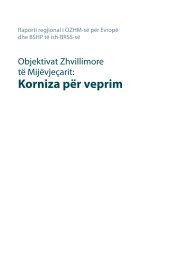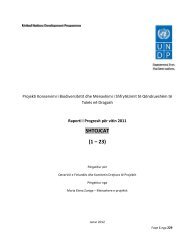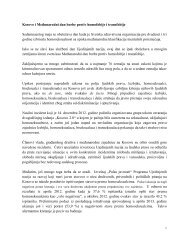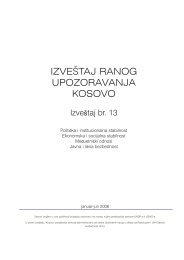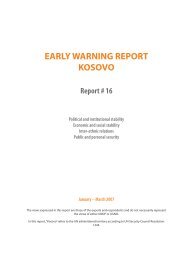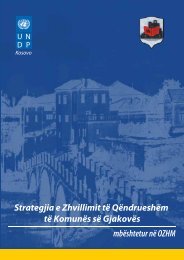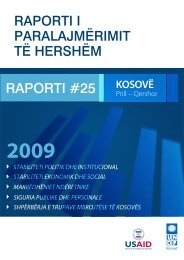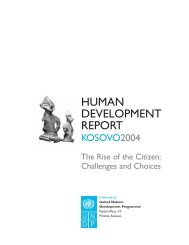Kosovo Human Development Report 2010 - UNDP Kosovo - United ...
Kosovo Human Development Report 2010 - UNDP Kosovo - United ...
Kosovo Human Development Report 2010 - UNDP Kosovo - United ...
Create successful ePaper yourself
Turn your PDF publications into a flip-book with our unique Google optimized e-Paper software.
Table<br />
1.1<br />
Low income<br />
and the launch of a renewed EC social<br />
agenda in 2008, have deepened the<br />
EU’s understanding of the centrality of<br />
social exclusion to its own goals. The<br />
EU and all its members now envisage<br />
their future in terms of opportunities,<br />
access, and solidarity - creating open<br />
societies and learning economies, empowering<br />
individuals to realise their<br />
potential while helping those unable<br />
to do so.<br />
The concept of social exclusion has<br />
therefore moved beyond economics<br />
and the labour force to encompass<br />
political and broader social and cultural<br />
dimensions. It defines the barriers to<br />
participation much more broadly and<br />
has correspondingly broadened the<br />
responsibilities of the State and other<br />
stakeholders to identify and address<br />
social, political, institutional and other<br />
European Union (Laeken) indicators<br />
barriers to social inclusion.<br />
Today, ‘combating social exclusion’<br />
is the driver behind the EU’s Open<br />
Method of Coordination (OMC) in the<br />
field of employment and social policies.<br />
The EU Social Protection and So-<br />
24 | KOSOVO HUMAN DEVELOPMENT REPORT <strong>2010</strong><br />
cial Inclusion Process or “social OMC”<br />
helps countries improve their own<br />
social policies through policy learning<br />
and exchange of good practices. The<br />
OMC was formalised in the context<br />
of the Lisbon Strategy, which united<br />
EU members to make their Union “the<br />
most competitive and dynamic knowledge-based<br />
economy in the world, capable<br />
of sustainable economic growth<br />
with more and better jobs and greater<br />
social cohesion”. 20 The EC monitors the<br />
processes of inclusion in its member<br />
states through various instruments<br />
such as the Laeken indicators. These are<br />
a set of 18 indicators which are used to<br />
monitor success in meeting Common<br />
Objectives of EU Social Policy Agenda<br />
aimed at alleviating poverty and social<br />
exclusion in member states (see Table<br />
1.1 below). 21<br />
Primary indicators Secondary indicators<br />
By age and gender Low income rate by threshold<br />
By work status Low income rate by fixed threshold<br />
By household type<br />
Low income rate before social<br />
transfers<br />
By housing tenure Gini coefficient<br />
Low income amounts<br />
By work status<br />
Persistent very low income<br />
Persistent low income<br />
Depth of low income<br />
Regional cohesion Long term unemployment share<br />
Work<br />
Long term unemployment rate<br />
Jobless households<br />
Very long term unemployment rate<br />
Education Not in education or training Low educational attainment<br />
Life expectancy at birth<br />
Health<br />
Self-defined health status<br />
Source: http://www.poverty.org.uk/summary/eu.htm, last accessed on September 26, <strong>2010</strong><br />
1.2<br />
Mechanisms and<br />
drivers of social<br />
exclusion<br />
Lack of power, or unequal power relations,<br />
is at the root of every type



